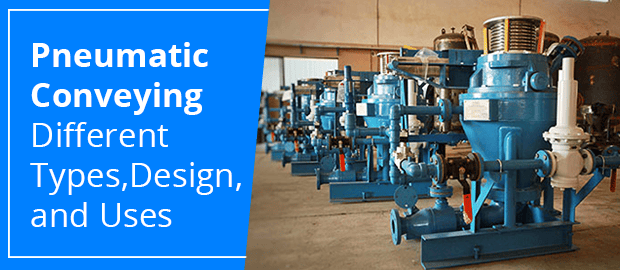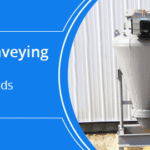If you are looking for a cost-effective system that can handle & transfer powdered and bulk granular materials seamlessly while ensuring the loss is minimal, then pneumatic conveying systems is just what you need. Pneumatic conveyor systems are ideal for different process industries namely chemicals, food & beverages, pet food, detergents, among others. Thus, let’s check out in detail what a pneumatic conveying system is, the different types of pneumatic conveyors, the advantages & disadvantages of pneumatic conveying as well as the pneumatic conveyors working principle.
A] What Is a Pneumatic Conveying System?
In simple words, Pneumatic conveying refers to a type of system that uses pressure differential and gas flow (usually air) to transfer dry bulk materials (powders & granules) from one process area to another. Moving bulk goods via air through enclosed conveying pipelines is the primary principle of pneumatic conveying. Here, the air movement is usually generated by a compressor, fan or root blower.
To convey bulk material through the conveying line, the flowing conveying air transmits a propulsion force. This requires a pressure difference between the start and end of the pipeline and to overcome this difference, compressors or conveying blowers are typically used. It also controls the positive/negative pressure as well as the airflow inside the conveying line, which allows the system to move the materials easily with very little loss or damage.
Learn How Pneumatic Conveying Can Transform Your Industry!
B] Advantages & Disadvantages of Pneumatic Conveying System
1. Advantages of Pneumatic Conveying System
- Safety: The biggest plus point of a pneumatic conveying system is the entire process of transferring materials is done inside an enclosed pipeline. This makes it highly safe to use. Also, the system has fewer moving parts, which makes it less dangerous to operators and maintenance workers.
- Adaptability: Pneumatic conveyor systems are flexible and can be easily adapted to any existing equipment. They are also space-saving, as they don’t require too much floor space. Plus, they allow you to set multiple pick-up points and discharges, thereby creating an efficient system.
- Ease of Routing: The pneumatic conveyor system can be routed any way you want – horizontally or vertically. It can easily cover long distances. In addition, you can design it around your existing equipment.
- Less spillage & dust leakage and better sanitisation: Since the materials are transferred through an enclosed pipeline, the material is well-contained which ensures there is less spillage and dust leakage compared to a mechanical conveying system. Likewise, the enclosed pipeline also reduces the risk of product contamination and ensures the plant remains clean and sanitised.
- Ease of Maintenance: As mentioned above, pneumatic conveying systems have fewer moving parts, thereby it requires less maintenance. Also, each component – tubing, separator, air compressor or pump, and in-feed device – can be repaired independently. This ensures that the downtime is limited and the maintenance work gets done quickly.
- Construction Flexibility: One of the major advantages of a pneumatic conveying system is that it can be custom-designed to fit around your existing equipment. The conveying lines are lightweight, so they don’t need too much structural support. With this system, you can also have multiple infeed and destinations points. Plus, it can also handle longer conveying distances. All these benefits – less space, less maintenance, enhanced flexibility – saves you a lot of money and eliminates several potential construction challenges.
2. Disadvantages of Pneumatic Conveying System
- Less energy efficiency: Since an air-stream is used to move material from one area to another, the pneumatic conveying system requires more power compared to a mechanical conveying system.
- Noise: The noise created by the blowers can be considerable. However, for large blowers, a sound enclosure is usually used.
- Not ideal for wet/fragile materials: Pneumatic conveying systems are best suited for lower density bulk powders (flour and sugar). They are not ideal for materials with larger particle size or wet products or combustible bulk solids. Also, the higher velocity and sharp turns in pneumatic conveying can damage fragile products and impact the end result.
- Larger dust collection system: It requires a larger dust collection system to separate materials from the conveying system’s air-stream at the destination area.
C] How Does a Pneumatic Conveying System Work?
Different pneumatic systems are created for various transportation methods. The energy required to move material through a pneumatic conveying system is supplied by pressure differential and airflow.
- Here, the pressure and airflow used in the conveying line are generated by the system’s air mover, which determines whether to generate pressure or vacuum to convey the material.
- When the system’s air mover is placed at the start, the system operates under pressure to convey the material.
- When the system’s air mover is placed at the end, the system operates under a vacuum to convey the material.
This manipulation of pressure differential and airflow inside the system helps convey materials from one point to another over certain distances.
A typical pneumatic conveyor system includes:
- Feed vessel: This is where the conveyor picks up the material that needs to be transported. A pressure system or a vacuum system is used by the feed point to pick up the material.
- Air mover: Using either a pressure system or a vacuum conveying system, the air is moved through the tube. In the pressure system, the air is pushed through the tubes. Whereas, the vacuum system pulls the air through the tubes to transfer materials.
- Transfer line: This is where the actual transfer of material takes place from one destination to another. Based on the design of the pneumatic conveyor system, the transfer line could be straight or have bends & elbows to guide the material down a longer conveyor path. If the transfer line has elbows, it may require additional blowers to guide the material through the tubes.
- Discharge vessel: This is where the material is collected after it has been discharged from the conveyor.
Learn How Pneumatic Conveying Can Transform Your Industry!
D] Types of Pneumatic Conveyors
There are two types of pneumatic conveyors – Dense Phase and Dilute Phase.
- Dense Phase Pneumatic Conveyors:- Dense phase pneumatic conveyors use a combination of low velocity and high pressure to move the material through the pipelines, which then accumulates at the bottom. It offers both – pressure conveying and vacuum conveying and is suitable for conveying extremely abrasive, friable and/or heavy materials such as cement, chemicals, metals, among others.
- Dilute Phase Pneumatic Conveyors:- To ensure that the material doesn’t get accumulated at the bottom, dilute phase pneumatic conveyors use a high velocity to keep the materials suspended in the air as it moves through the conveying pipe. The dilute phase offers both – pressure conveying and vacuum conveying and is ideal for conveying less abrasive materials such as flour, pelletized products, resins, sawdust, etc.
Further reading: Difference Between Dense Phase and Dilute Phase Pneumatic Conveying Systems
E] Applications and Uses of Pneumatic Conveyor Systems
We understand that the process of determining the scope and designing & installing a pneumatic conveying system can be challenging. Any mistake can prove to be costly. Thus, you can easily avoid this by partnering with Macawber – an experienced pneumatic conveyor system provider.
Some of the things to consider when selecting a dilute or dense phase pneumatic conveying system for your application is:
- The material’s characteristics – particle size distribution and shape, density, fluidisation, moisture content, concentration, hardness/friability, etc.
- Take into consideration the ambient air temperature, humidity, and altitude of the location where the system will be installed.
- Consider the system’s distance & throughput and angles of slip, flow and repose.
This can help you to choose the right system that works for your process as well as budget. But, if you are still unsure which is best for you, then you can simply email us your requirement or call us, and we’ll help you design a system that suits your exact specifications.



